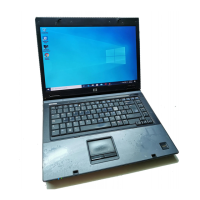Connecting a USB device
CAUTION: To prevent damage to a USB connector, use minimal force to connect a USB
device.
To connect a USB device to the computer, connect the USB cable for the device to the USB port. You
will hear a sound when the device has been detected.
NOTE: The first time you connect a USB device, the “Found New Hardware” message is
displayed in the notification area, at the far right of the taskbar.
Stopping a USB device
CAUTION: To prevent loss of information or an unresponsive system, stop the USB device
before removing it.
CAUTION: To prevent damage to a USB connector, do not pull on the cable to disconnect the
USB device.
To stop a USB device:
1. Double-click the Safely Remove Hardware icon in the notification area, at the far right of the
taskbar.
NOTE: To display the Safely Remove Hardware icon, click the Show Hidden Icons icon
(< or <<) in the notification area.
2. Click the name of the device in the list.
NOTE: If the USB device is not listed, you do not have to stop the device before you
remove it.
3. Click Stop, and then click OK.
USB legacy support
USB legacy support (enabled by default) allows you to
●
Use a USB keyboard, mouse, or hub connected to a USB port on the computer during startup or
in a non Windows® program or utility.
●
Start or restart from an optional external MultiBay or an optional USB bootable device.
USB legacy support is enabled at the factory. To disable or enable USB legacy support:
1. Open Computer Setup by turning on or restarting the computer, and then pressing f10 while the
“F10 = ROM Based Setup” message is displayed in the lower-left corner of the screen.
2. Use the arrow keys to select System Configuration > Device configurations, and then press
enter.
2 Chapter 1 Using a USB device ENWW

